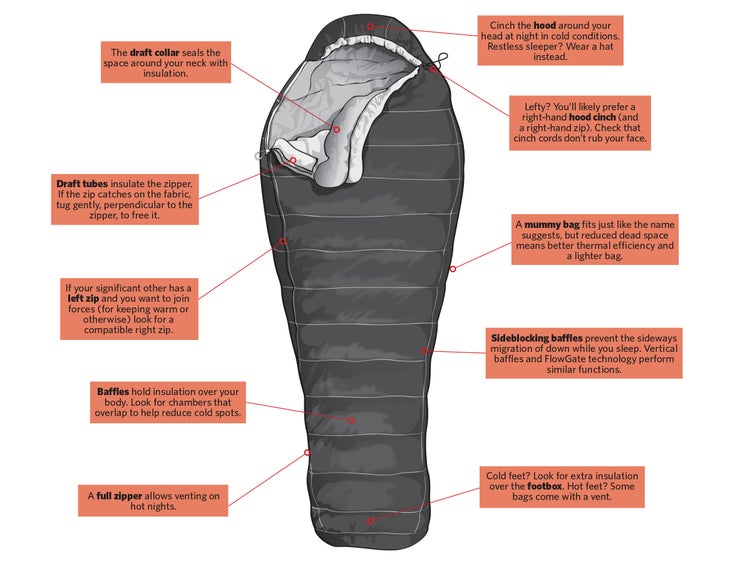Products You May Like
Get full access to Outside Learn, our online education hub featuring in-depth fitness, nutrition, and adventure courses and more than 2,000 instructional videos when you sign up for Outside+
Sign up for Outside+ today.
Brush up on backpacking basics with tips, tricks, and advice from Backpacker’s experts in Hiking 101.
The Sleeping Bag Expert
Christin Schoettle started hiking with her mom before she could walk. She’s been working at Half Moon Outfitters since 2008. “Shopping for bags can be daunting, but the minute you put them on the floor and tell people to crawl in, they start to figure out what they need,” she says. “It’s about having a hands-on experience.”
How to Buy a Sleeping Bag: Ask the Right Questions
What shape do I need? Mummy bags seal in heat better (and are lighter), but can feel claustrophobic. If you sleep big (or prioritize comfort over weight),
find a rectangular or semi-rectangular bag.
What kind of insulation do I need? Down is compressible and long-lasting, and synthetic is inexpensive, keeps you warm when wet, and dries fast, but that’s not the whole story. Ask your sales associate how well synthetics mimic down. For example, short-staple insulation better imitates feathers in terms of compressibility, but doesn’t last long. Continuous filament insulation has better longevity but worse packability.
Does the rest of my system complement this bag? During EN testing (see top right), heat-sensing lab mannequins wear long underwear and lie on a foam sleeping pad. Your pad, bag, tent, and layers all work together to keep you warm.
How often is this bag returned? “I have a war story about everything,” Schoettle says. Ask about the bag’s durability and about feedback from other customers, and you might get some anecdotes to help inform your purchase.
How does it feel? Get into each one and test roll-around room, zipper action and accessibility, and hood cinch. Then pack each bag into its stuffsack to check compressibility.
Anatomy of a Sleeping Bag
Learn your way around your sleeping bag. (Too small to read? Click the image to view the full-size version.)

Reading the Fine Print
“People see a 20°F bag and assume they’ll be warm all the way down to 20°F,” Schoettle says. Brands aren’t required to list the standardized EN temperature ratings in the product name, and two bags called the “20” often perform differently. Buy based on the EN comfort range printed on the bag.
Sleeping Bag Owner’s Manual
Don’t pick. Plucking feathers can widen small holes. Instead, pinch escapees back in from the inside.
Sleep clean. Wear baselayers to bed to keep body oils off your bag.
Let it breathe. Hang your bedding in the sun while you make breakfast, and avoid burrowing in at night; exhaled vapor wilts insulation (plus it stinks in there). Never store your bag compressed.
Keep your distance. Don’t sleep too close to fires and stoves; airborne embers can leave tiny holes in synthetic fabrics.
Basic Sleeping Bag Repair
Chelsea Chon, general manager at Seattle’s Rainy Pass Repair, has seen plenty of mutilated bags during her three-year tenure, including one with the bottom burnt out by hot rocks intended for toe warming (genius). Here are a few of the more common complaints she receives.
“Lost loft.” People often request a down replacement when all they need is a good cleaning to re-fluff dirty feathers. Use down wash.
Lost loft. Send your bag in for a refill if down escapes through a tear. The repair shop will inject new feathers into each baffled chamber.
Small punctures. Clean the area around the tear with rubbing alcohol. Trim frayed threads, then patch with repair tape.
Gaping holes. Get too close to a fire? Tape up splits as best you can in the field, then dispatch it to the pros after your trip.
Learn the Sleeping Bag Lingo
Reverse differential: Describes a bag design in which the fabric used for the bag’s interior is cut larger than the shell fabric. The result? Insulation lofts up where there’s room—between your chest and arms, and between your legs—to fill in dead space and boost warmth.
